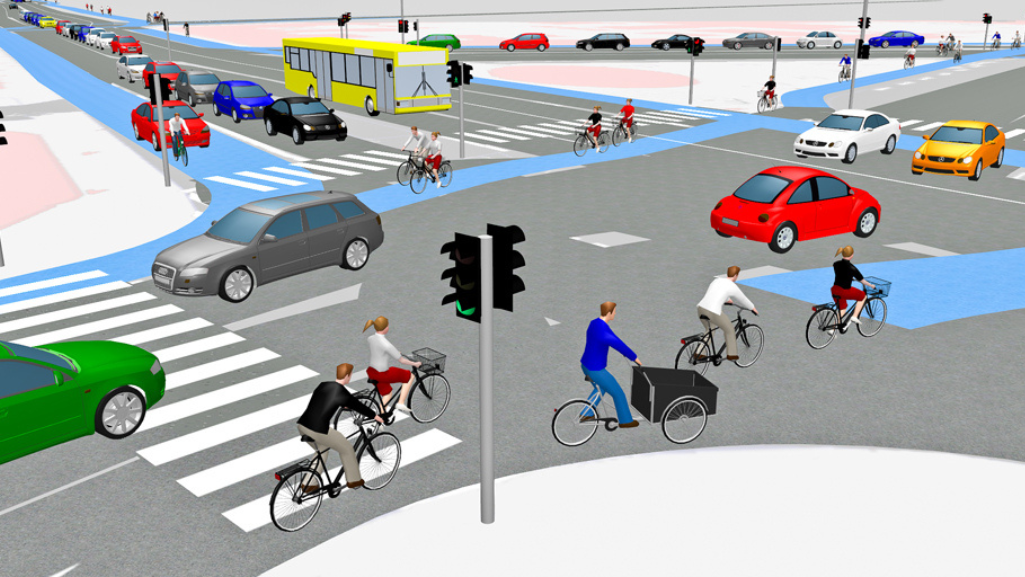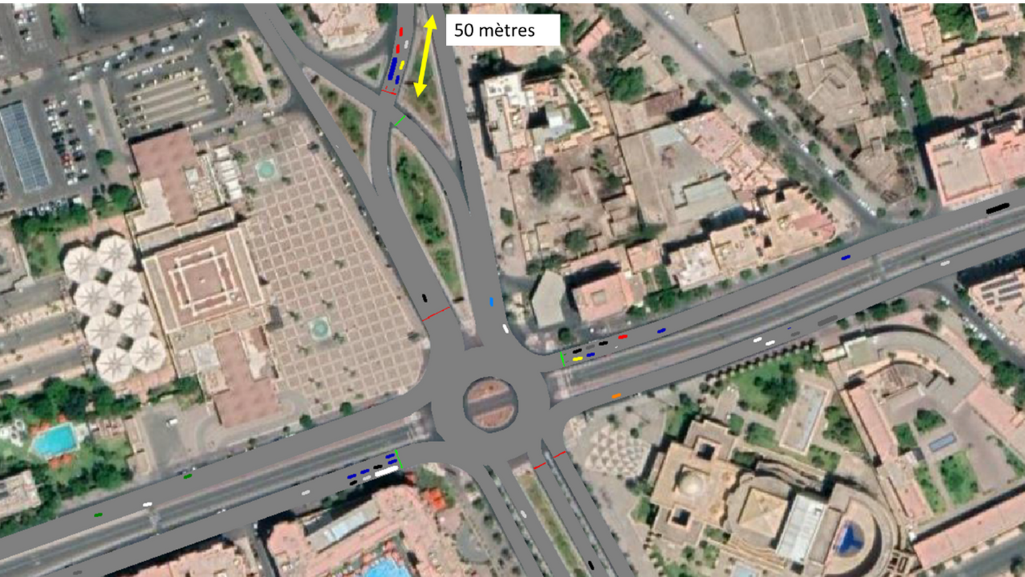Table of contents
To ensure the success of mobility projects – from widening a road, to adapting signal times, to building a bike lane – professionals need realistic traffic simulations. But not all traffic simulations are created equal: Those that best reflect driver behavior give planners a huge advantage – the most accuracy.
Here are some key things to know about realistic traffic simulations that include driver behavior.
Recreating reality: different motion models
The traffic on our roads is dynamic and complex. Many parameters affect the traffic situation, with implications for traffic flow, road safety, and energy consumption.
A critical factor is the behavior and interaction of road users. The ability to accurately model the behavior and interaction of motorized private vehicles, public transit, bicyclists, and pedestrians is key to realistic traffic modeling.
The most accurate mobility simulation software tools, like PTV Vissim, are those that represent all those modes of transportation and simulate their interaction. And at the core of these microscopic traffic simulations are the modeling of driving behavior.
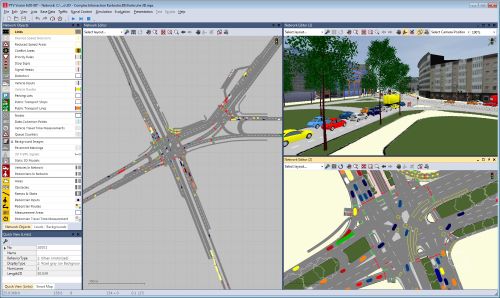
PTV Vissim: Application of advanced driving behavior models
Vehicle movement models are a key element in realistically simulating traffic dynamics. PTV Vissim uses three advanced vehicle motion models:
1. The Following Model
The psycho-physical car-following model, developed by Prof. Rainer Wiedemann of the Karlsruhe Institute of Technology, describes the movement of traffic on a single lane. This model, which is unique for PTV Vissim, can be adapted to local conditions by the user through parameters. The Following Model describes 4 states:
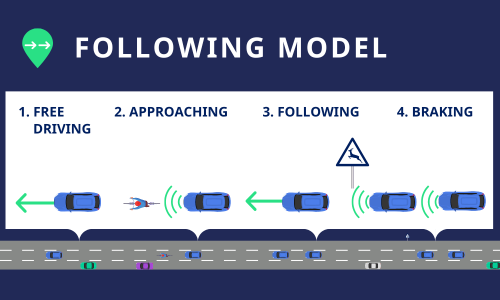
- Free Driving – The driver drives at the desired speed, provided there are no obstacles (slower vehicles, red lights, etc.) ahead.
- Approaching – The driver detects a slow vehicle ahead and brakes within the desired distance. In PTV Vissim it is possible to define different driver and vehicle types, such as the rate of deceleration when approaching the vehicle in front.
- Following – The driver tries to keep the distance from the vehicle in front when following it. However, the distance between the two vehicles varies – sometimes the speed is slightly higher, sometimes lower.
- Braking – When one vehicle reduces its speed, the vehicle behind it must also brake. For each vehicle, Vissim checks the distance and speed differences with respect to the vehicle in front at each simulation time step.
2. The Lane Changing Model
Traffic simulation tools, such as PTV Vissim, use this model to evaluate the impact of lane-changing dynamics on traffic flow. This model considers two different types of lane changing, based on the driver’s motivation:
- Free lane change – when overtaking slow moving vehicles, i.e. when an individual’s desired speed is higher than the person in front.
- Necessary lane changing – when the driver needs to change lanes, e.g. to follow a route. The closer the driver gets to the emergency distance, the more aggressive the driver is and more willing to accept obstructions from other drivers.
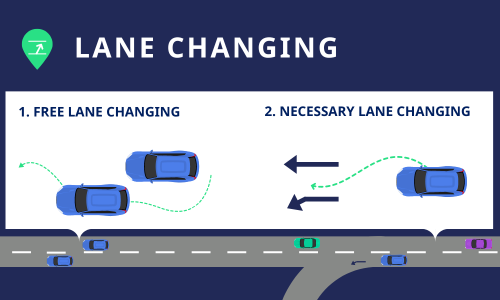
3. The Lateral Behavior Within a Lane Model
This model deals with non-lane-based behavior. The choice of position within a lane is important if vehicles can overtake each other within a particular lane and are able to be side-by-side. This is the case on cycle paths or on regular streets in certain regions, for example.
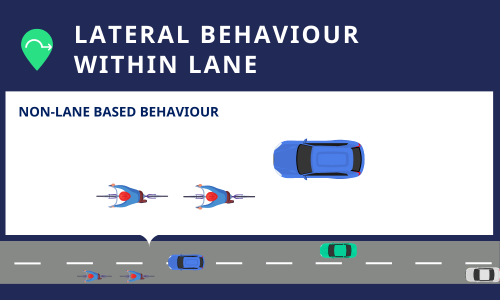
Use cases of realistic traffic simulations
Realistic traffic simulations are valuable tools in transportation research. They can be applied to various contexts, including both urban and rural environments. The simulations, however, become more accurate when they incorporate driver behavior, such as in these use cases:
Scenario Testing: Simulations allow researchers to create and test various driving scenarios in different environments, considering factors such as road conditions and congestion.
Environmental Variability: Simulations with driver behavior consider unique characteristics of different road geometries and traffic density. These factors influence driver decision-making and reactions, and simulations can model these elements to predict behavior.
Safety Analysis: Simulations are instrumental in safety analysis, including the evaluation of potential risks and the assessment of driver responses in diverse settings. This is crucial for understanding how drivers behave when encountering hazards.
Human Factor Studies: Driver behavior is essential in simulations of human factor studies. They allow for analysis of how drivers respond to external stimuli and make decisions. These studies provide insights into how drivers adapt their behavior to different environments.
Autonomous Vehicle Testing: As autonomous vehicles are developed and tested, simulations help in assessing their performance in various scenarios. Predicting how these vehicles will interact with the environment and other road users is essential for their successful integration.
Policy Evaluation: Simulations can be used to evaluate the impact of transportation policies or infrastructure changes. For example, assessing the effect of road design modifications or speed limit changes on driving behavior.
Examples of realistic traffic simulations
For cities, there are many benefits for using traffic simulations that consider driving behavior during urban planning processes.
The city of Los Angeles, for example, faces constant challenges in managing its sprawling road network. It has turned to advanced simulation tools to examine traffic data sets from across the Los Angeles region to develop new strategies to reduce traffic congestion.
Similarly, Transport for London (TfL) uses simulation models to predict the impact of population growth and urban development on the city’s transportation infrastructure.
By simulating different scenarios, TfL can make informed decisions about where and how to invest in new transportation projects. This ensures the UK capital city remains resilient in the face of evolving urban dynamics.
The use of realistic traffic simulations such as PTV Vissim has led to many mobility success stories. Check out these examples from England, Denmark, and Spain.

Why would you use a traffic simulation?
Discover our ultimate guide to traffic simulation

Why Would You Use a Traffic Simulation?
Answers to the most important questions around traffic modeling and simulation
